Exploring Communication Strategies in Health and Social Care Sector
VerifiedAdded on 2023/06/15
|9
|1875
|406
Report
AI Summary
This report provides an overview of communication in health and social care, detailing various methods such as face-to-face conversations, emails, and non-verbal cues. It assesses the strengths and weaknesses of formal and informal communication, emphasizing the importance of clarity, objectivity, and consistency. The report also identifies potential barriers to effective communication and suggests strategies for overcoming them, such as using simple language and selecting appropriate mediums. Furthermore, it examines the benefits and hazards of technology in organizational and service user communications, addressing issues related to data protection and its implementation within the healthcare sector. The report concludes by referencing key sources that support the analysis and recommendations provided.
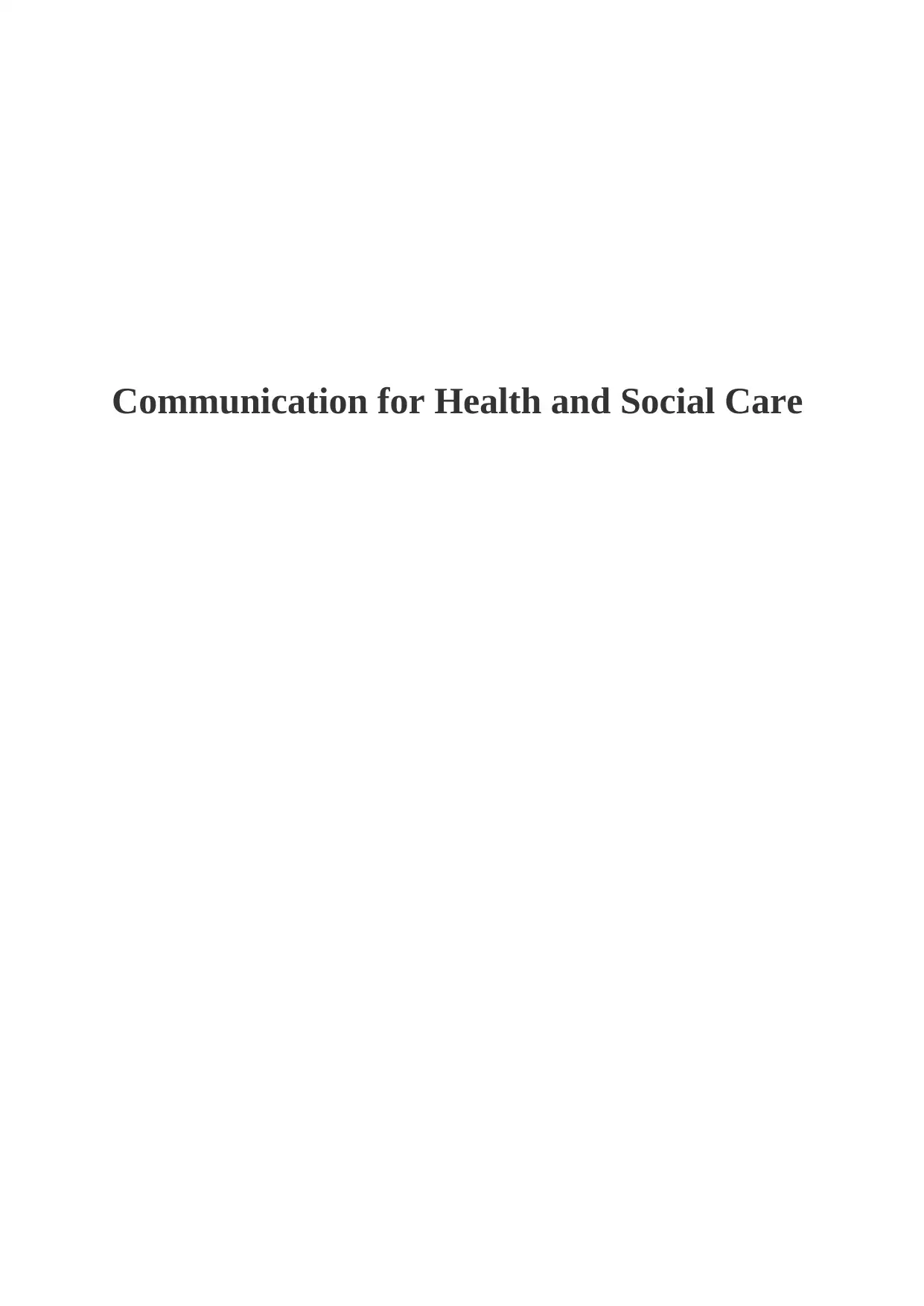
Communication for Health and Social Care
Paraphrase This Document
Need a fresh take? Get an instant paraphrase of this document with our AI Paraphraser
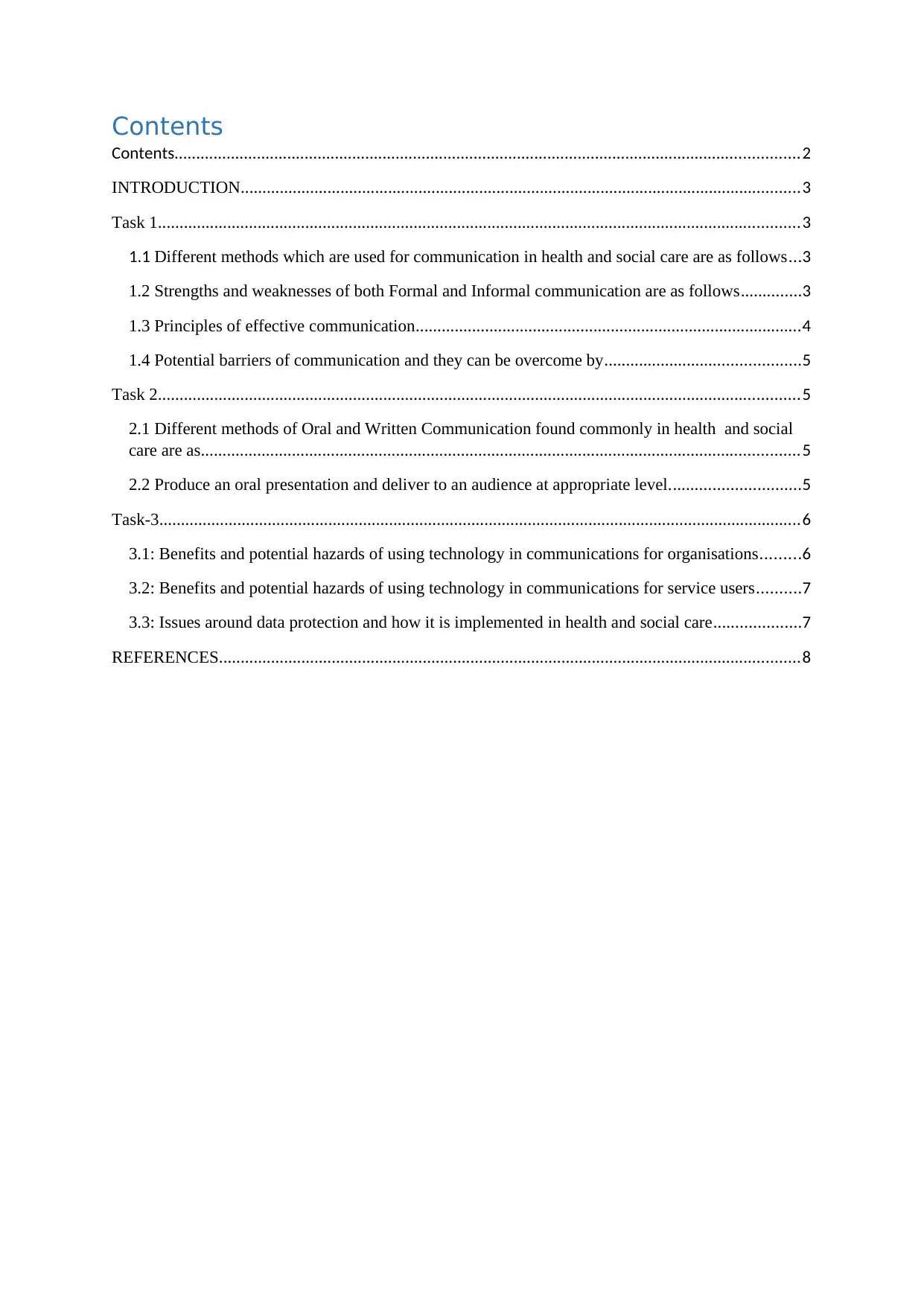
Contents
Contents................................................................................................................................................2
INTRODUCTION.................................................................................................................................3
Task 1....................................................................................................................................................3
1.1 Different methods which are used for communication in health and social care are as follows...3
1.2 Strengths and weaknesses of both Formal and Informal communication are as follows..............3
1.3 Principles of effective communication.........................................................................................4
1.4 Potential barriers of communication and they can be overcome by.............................................5
Task 2....................................................................................................................................................5
2.1 Different methods of Oral and Written Communication found commonly in health and social
care are as..........................................................................................................................................5
2.2 Produce an oral presentation and deliver to an audience at appropriate level..............................5
Task-3....................................................................................................................................................6
3.1: Benefits and potential hazards of using technology in communications for organisations.........6
3.2: Benefits and potential hazards of using technology in communications for service users..........7
3.3: Issues around data protection and how it is implemented in health and social care....................7
REFERENCES......................................................................................................................................8
Contents................................................................................................................................................2
INTRODUCTION.................................................................................................................................3
Task 1....................................................................................................................................................3
1.1 Different methods which are used for communication in health and social care are as follows...3
1.2 Strengths and weaknesses of both Formal and Informal communication are as follows..............3
1.3 Principles of effective communication.........................................................................................4
1.4 Potential barriers of communication and they can be overcome by.............................................5
Task 2....................................................................................................................................................5
2.1 Different methods of Oral and Written Communication found commonly in health and social
care are as..........................................................................................................................................5
2.2 Produce an oral presentation and deliver to an audience at appropriate level..............................5
Task-3....................................................................................................................................................6
3.1: Benefits and potential hazards of using technology in communications for organisations.........6
3.2: Benefits and potential hazards of using technology in communications for service users..........7
3.3: Issues around data protection and how it is implemented in health and social care....................7
REFERENCES......................................................................................................................................8
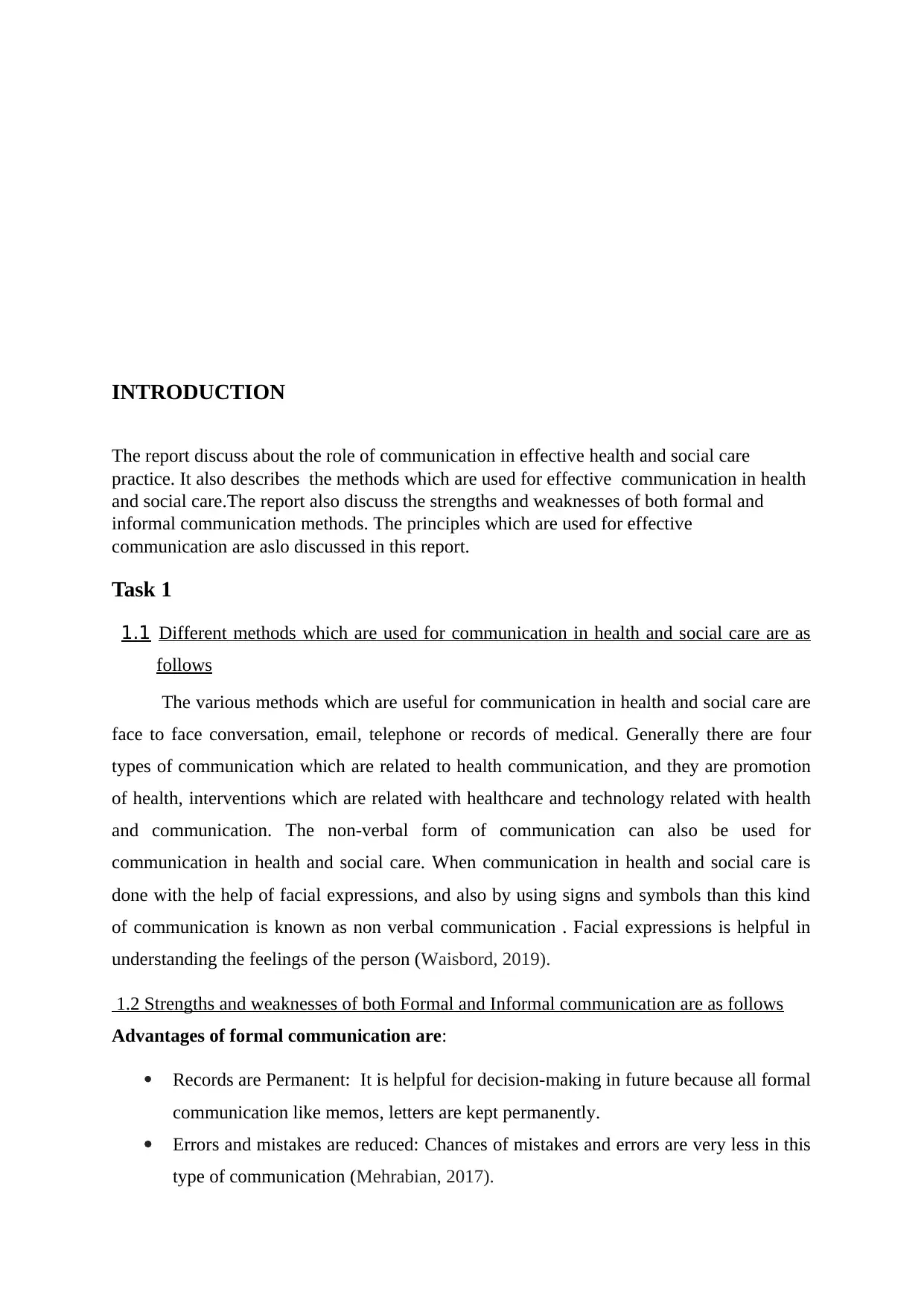
INTRODUCTION
The report discuss about the role of communication in effective health and social care
practice. It also describes the methods which are used for effective communication in health
and social care.The report also discuss the strengths and weaknesses of both formal and
informal communication methods. The principles which are used for effective
communication are aslo discussed in this report.
Task 1
1.1 Different methods which are used for communication in health and social care are as
follows
The various methods which are useful for communication in health and social care are
face to face conversation, email, telephone or records of medical. Generally there are four
types of communication which are related to health communication, and they are promotion
of health, interventions which are related with healthcare and technology related with health
and communication. The non-verbal form of communication can also be used for
communication in health and social care. When communication in health and social care is
done with the help of facial expressions, and also by using signs and symbols than this kind
of communication is known as non verbal communication . Facial expressions is helpful in
understanding the feelings of the person (Waisbord, 2019).
1.2 Strengths and weaknesses of both Formal and Informal communication are as follows
Advantages of formal communication are:
Records are Permanent: It is helpful for decision-making in future because all formal
communication like memos, letters are kept permanently.
Errors and mistakes are reduced: Chances of mistakes and errors are very less in this
type of communication (Mehrabian, 2017).
The report discuss about the role of communication in effective health and social care
practice. It also describes the methods which are used for effective communication in health
and social care.The report also discuss the strengths and weaknesses of both formal and
informal communication methods. The principles which are used for effective
communication are aslo discussed in this report.
Task 1
1.1 Different methods which are used for communication in health and social care are as
follows
The various methods which are useful for communication in health and social care are
face to face conversation, email, telephone or records of medical. Generally there are four
types of communication which are related to health communication, and they are promotion
of health, interventions which are related with healthcare and technology related with health
and communication. The non-verbal form of communication can also be used for
communication in health and social care. When communication in health and social care is
done with the help of facial expressions, and also by using signs and symbols than this kind
of communication is known as non verbal communication . Facial expressions is helpful in
understanding the feelings of the person (Waisbord, 2019).
1.2 Strengths and weaknesses of both Formal and Informal communication are as follows
Advantages of formal communication are:
Records are Permanent: It is helpful for decision-making in future because all formal
communication like memos, letters are kept permanently.
Errors and mistakes are reduced: Chances of mistakes and errors are very less in this
type of communication (Mehrabian, 2017).
⊘ This is a preview!⊘
Do you want full access?
Subscribe today to unlock all pages.

Trusted by 1+ million students worldwide
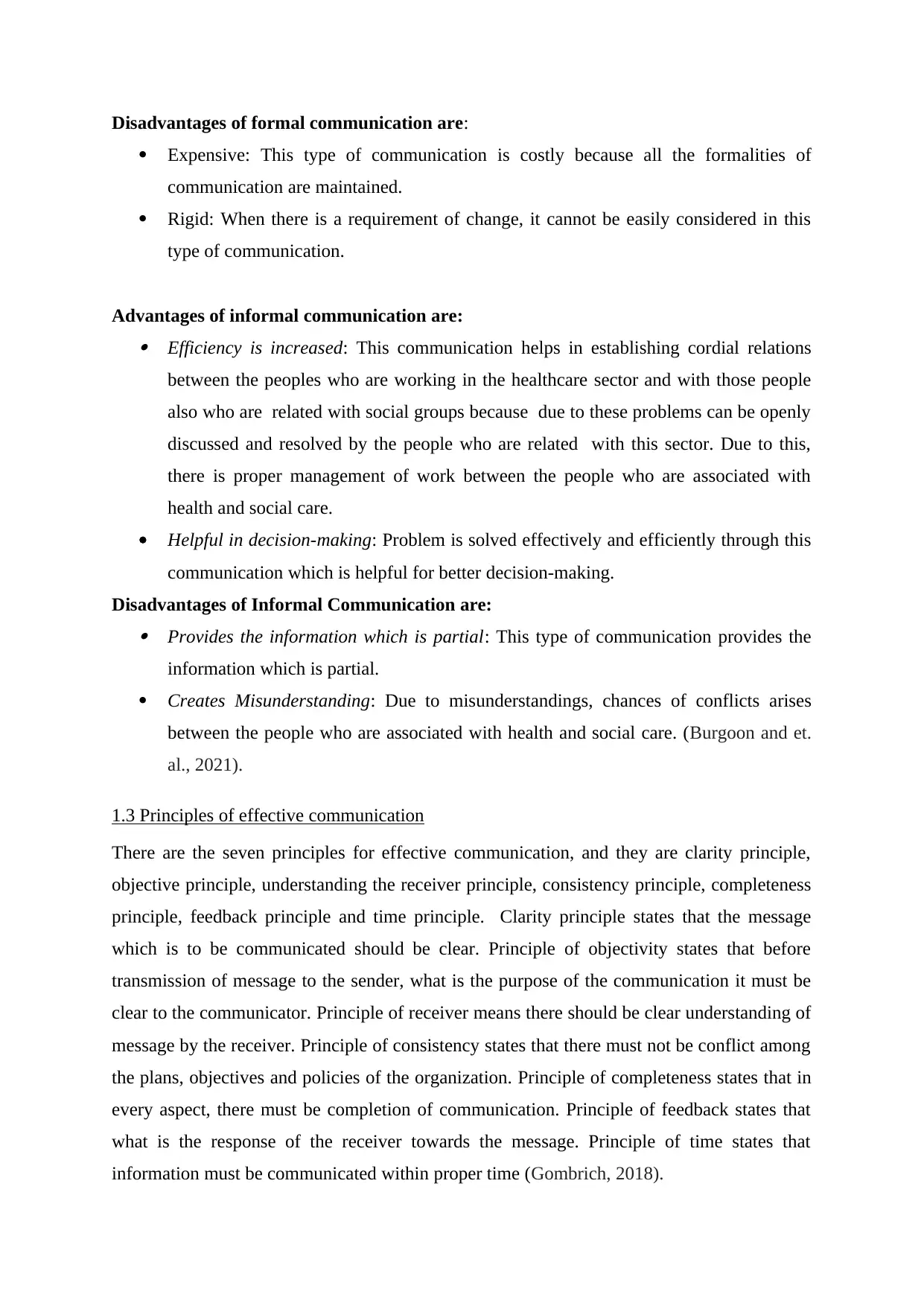
Disadvantages of formal communication are:
Expensive: This type of communication is costly because all the formalities of
communication are maintained.
Rigid: When there is a requirement of change, it cannot be easily considered in this
type of communication.
Advantages of informal communication are: Efficiency is increased: This communication helps in establishing cordial relations
between the peoples who are working in the healthcare sector and with those people
also who are related with social groups because due to these problems can be openly
discussed and resolved by the people who are related with this sector. Due to this,
there is proper management of work between the people who are associated with
health and social care.
Helpful in decision-making: Problem is solved effectively and efficiently through this
communication which is helpful for better decision-making.
Disadvantages of Informal Communication are: Provides the information which is partial: This type of communication provides the
information which is partial.
Creates Misunderstanding: Due to misunderstandings, chances of conflicts arises
between the people who are associated with health and social care. (Burgoon and et.
al., 2021).
1.3 Principles of effective communication
There are the seven principles for effective communication, and they are clarity principle,
objective principle, understanding the receiver principle, consistency principle, completeness
principle, feedback principle and time principle. Clarity principle states that the message
which is to be communicated should be clear. Principle of objectivity states that before
transmission of message to the sender, what is the purpose of the communication it must be
clear to the communicator. Principle of receiver means there should be clear understanding of
message by the receiver. Principle of consistency states that there must not be conflict among
the plans, objectives and policies of the organization. Principle of completeness states that in
every aspect, there must be completion of communication. Principle of feedback states that
what is the response of the receiver towards the message. Principle of time states that
information must be communicated within proper time (Gombrich, 2018).
Expensive: This type of communication is costly because all the formalities of
communication are maintained.
Rigid: When there is a requirement of change, it cannot be easily considered in this
type of communication.
Advantages of informal communication are: Efficiency is increased: This communication helps in establishing cordial relations
between the peoples who are working in the healthcare sector and with those people
also who are related with social groups because due to these problems can be openly
discussed and resolved by the people who are related with this sector. Due to this,
there is proper management of work between the people who are associated with
health and social care.
Helpful in decision-making: Problem is solved effectively and efficiently through this
communication which is helpful for better decision-making.
Disadvantages of Informal Communication are: Provides the information which is partial: This type of communication provides the
information which is partial.
Creates Misunderstanding: Due to misunderstandings, chances of conflicts arises
between the people who are associated with health and social care. (Burgoon and et.
al., 2021).
1.3 Principles of effective communication
There are the seven principles for effective communication, and they are clarity principle,
objective principle, understanding the receiver principle, consistency principle, completeness
principle, feedback principle and time principle. Clarity principle states that the message
which is to be communicated should be clear. Principle of objectivity states that before
transmission of message to the sender, what is the purpose of the communication it must be
clear to the communicator. Principle of receiver means there should be clear understanding of
message by the receiver. Principle of consistency states that there must not be conflict among
the plans, objectives and policies of the organization. Principle of completeness states that in
every aspect, there must be completion of communication. Principle of feedback states that
what is the response of the receiver towards the message. Principle of time states that
information must be communicated within proper time (Gombrich, 2018).
Paraphrase This Document
Need a fresh take? Get an instant paraphrase of this document with our AI Paraphraser
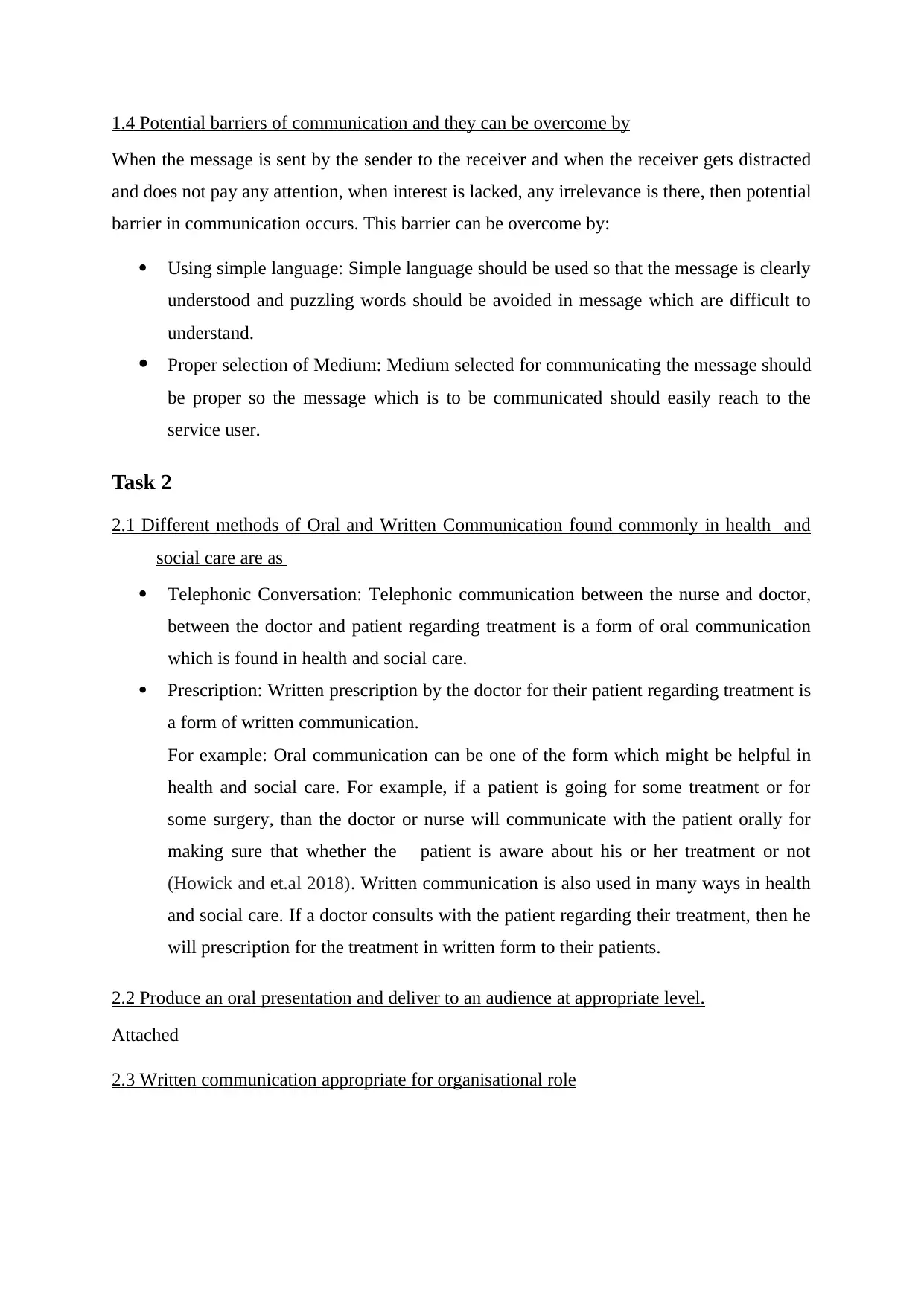
1.4 Potential barriers of communication and they can be overcome by
When the message is sent by the sender to the receiver and when the receiver gets distracted
and does not pay any attention, when interest is lacked, any irrelevance is there, then potential
barrier in communication occurs. This barrier can be overcome by:
Using simple language: Simple language should be used so that the message is clearly
understood and puzzling words should be avoided in message which are difficult to
understand.
Proper selection of Medium: Medium selected for communicating the message should
be proper so the message which is to be communicated should easily reach to the
service user.
Task 2
2.1 Different methods of Oral and Written Communication found commonly in health and
social care are as
Telephonic Conversation: Telephonic communication between the nurse and doctor,
between the doctor and patient regarding treatment is a form of oral communication
which is found in health and social care.
Prescription: Written prescription by the doctor for their patient regarding treatment is
a form of written communication.
For example: Oral communication can be one of the form which might be helpful in
health and social care. For example, if a patient is going for some treatment or for
some surgery, than the doctor or nurse will communicate with the patient orally for
making sure that whether the patient is aware about his or her treatment or not
(Howick and et.al 2018). Written communication is also used in many ways in health
and social care. If a doctor consults with the patient regarding their treatment, then he
will prescription for the treatment in written form to their patients.
2.2 Produce an oral presentation and deliver to an audience at appropriate level.
Attached
2.3 Written communication appropriate for organisational role
When the message is sent by the sender to the receiver and when the receiver gets distracted
and does not pay any attention, when interest is lacked, any irrelevance is there, then potential
barrier in communication occurs. This barrier can be overcome by:
Using simple language: Simple language should be used so that the message is clearly
understood and puzzling words should be avoided in message which are difficult to
understand.
Proper selection of Medium: Medium selected for communicating the message should
be proper so the message which is to be communicated should easily reach to the
service user.
Task 2
2.1 Different methods of Oral and Written Communication found commonly in health and
social care are as
Telephonic Conversation: Telephonic communication between the nurse and doctor,
between the doctor and patient regarding treatment is a form of oral communication
which is found in health and social care.
Prescription: Written prescription by the doctor for their patient regarding treatment is
a form of written communication.
For example: Oral communication can be one of the form which might be helpful in
health and social care. For example, if a patient is going for some treatment or for
some surgery, than the doctor or nurse will communicate with the patient orally for
making sure that whether the patient is aware about his or her treatment or not
(Howick and et.al 2018). Written communication is also used in many ways in health
and social care. If a doctor consults with the patient regarding their treatment, then he
will prescription for the treatment in written form to their patients.
2.2 Produce an oral presentation and deliver to an audience at appropriate level.
Attached
2.3 Written communication appropriate for organisational role
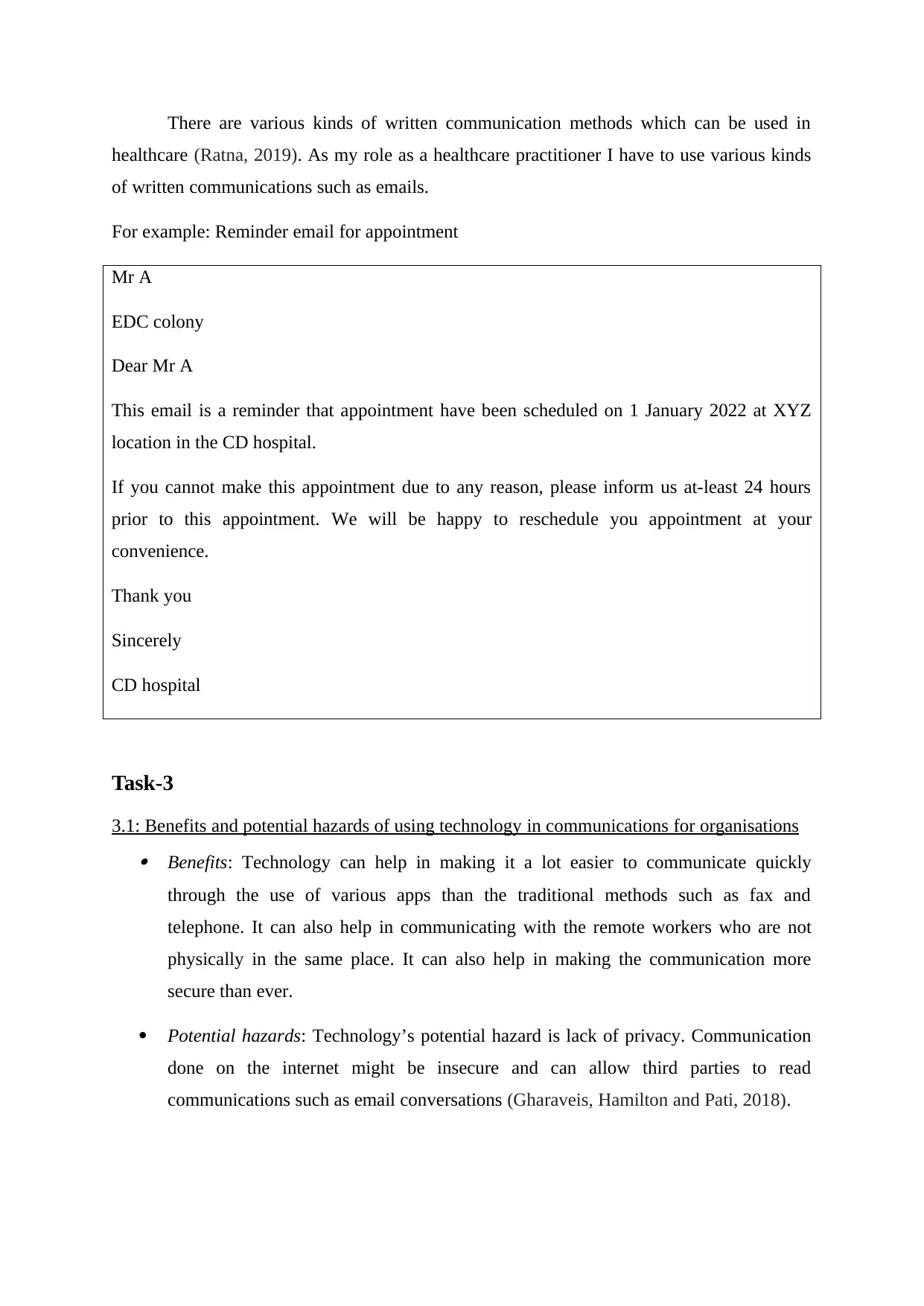
There are various kinds of written communication methods which can be used in
healthcare (Ratna, 2019). As my role as a healthcare practitioner I have to use various kinds
of written communications such as emails.
For example: Reminder email for appointment
Mr A
EDC colony
Dear Mr A
This email is a reminder that appointment have been scheduled on 1 January 2022 at XYZ
location in the CD hospital.
If you cannot make this appointment due to any reason, please inform us at-least 24 hours
prior to this appointment. We will be happy to reschedule you appointment at your
convenience.
Thank you
Sincerely
CD hospital
Task-3
3.1: Benefits and potential hazards of using technology in communications for organisations Benefits: Technology can help in making it a lot easier to communicate quickly
through the use of various apps than the traditional methods such as fax and
telephone. It can also help in communicating with the remote workers who are not
physically in the same place. It can also help in making the communication more
secure than ever.
Potential hazards: Technology’s potential hazard is lack of privacy. Communication
done on the internet might be insecure and can allow third parties to read
communications such as email conversations (Gharaveis, Hamilton and Pati, 2018).
healthcare (Ratna, 2019). As my role as a healthcare practitioner I have to use various kinds
of written communications such as emails.
For example: Reminder email for appointment
Mr A
EDC colony
Dear Mr A
This email is a reminder that appointment have been scheduled on 1 January 2022 at XYZ
location in the CD hospital.
If you cannot make this appointment due to any reason, please inform us at-least 24 hours
prior to this appointment. We will be happy to reschedule you appointment at your
convenience.
Thank you
Sincerely
CD hospital
Task-3
3.1: Benefits and potential hazards of using technology in communications for organisations Benefits: Technology can help in making it a lot easier to communicate quickly
through the use of various apps than the traditional methods such as fax and
telephone. It can also help in communicating with the remote workers who are not
physically in the same place. It can also help in making the communication more
secure than ever.
Potential hazards: Technology’s potential hazard is lack of privacy. Communication
done on the internet might be insecure and can allow third parties to read
communications such as email conversations (Gharaveis, Hamilton and Pati, 2018).
⊘ This is a preview!⊘
Do you want full access?
Subscribe today to unlock all pages.

Trusted by 1+ million students worldwide
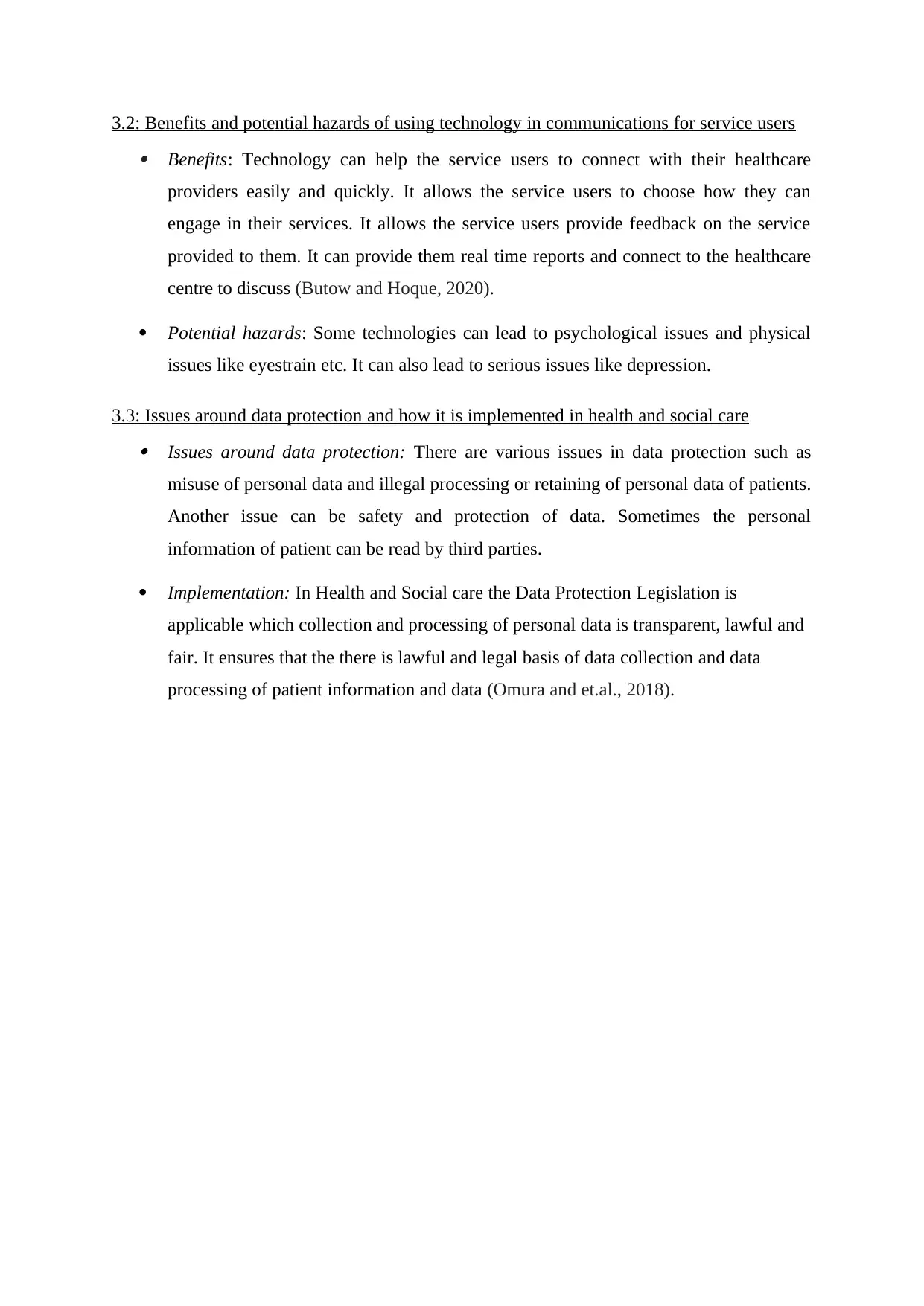
3.2: Benefits and potential hazards of using technology in communications for service users Benefits: Technology can help the service users to connect with their healthcare
providers easily and quickly. It allows the service users to choose how they can
engage in their services. It allows the service users provide feedback on the service
provided to them. It can provide them real time reports and connect to the healthcare
centre to discuss (Butow and Hoque, 2020).
Potential hazards: Some technologies can lead to psychological issues and physical
issues like eyestrain etc. It can also lead to serious issues like depression.
3.3: Issues around data protection and how it is implemented in health and social care Issues around data protection: There are various issues in data protection such as
misuse of personal data and illegal processing or retaining of personal data of patients.
Another issue can be safety and protection of data. Sometimes the personal
information of patient can be read by third parties.
Implementation: In Health and Social care the Data Protection Legislation is
applicable which collection and processing of personal data is transparent, lawful and
fair. It ensures that the there is lawful and legal basis of data collection and data
processing of patient information and data (Omura and et.al., 2018).
providers easily and quickly. It allows the service users to choose how they can
engage in their services. It allows the service users provide feedback on the service
provided to them. It can provide them real time reports and connect to the healthcare
centre to discuss (Butow and Hoque, 2020).
Potential hazards: Some technologies can lead to psychological issues and physical
issues like eyestrain etc. It can also lead to serious issues like depression.
3.3: Issues around data protection and how it is implemented in health and social care Issues around data protection: There are various issues in data protection such as
misuse of personal data and illegal processing or retaining of personal data of patients.
Another issue can be safety and protection of data. Sometimes the personal
information of patient can be read by third parties.
Implementation: In Health and Social care the Data Protection Legislation is
applicable which collection and processing of personal data is transparent, lawful and
fair. It ensures that the there is lawful and legal basis of data collection and data
processing of patient information and data (Omura and et.al., 2018).
Paraphrase This Document
Need a fresh take? Get an instant paraphrase of this document with our AI Paraphraser
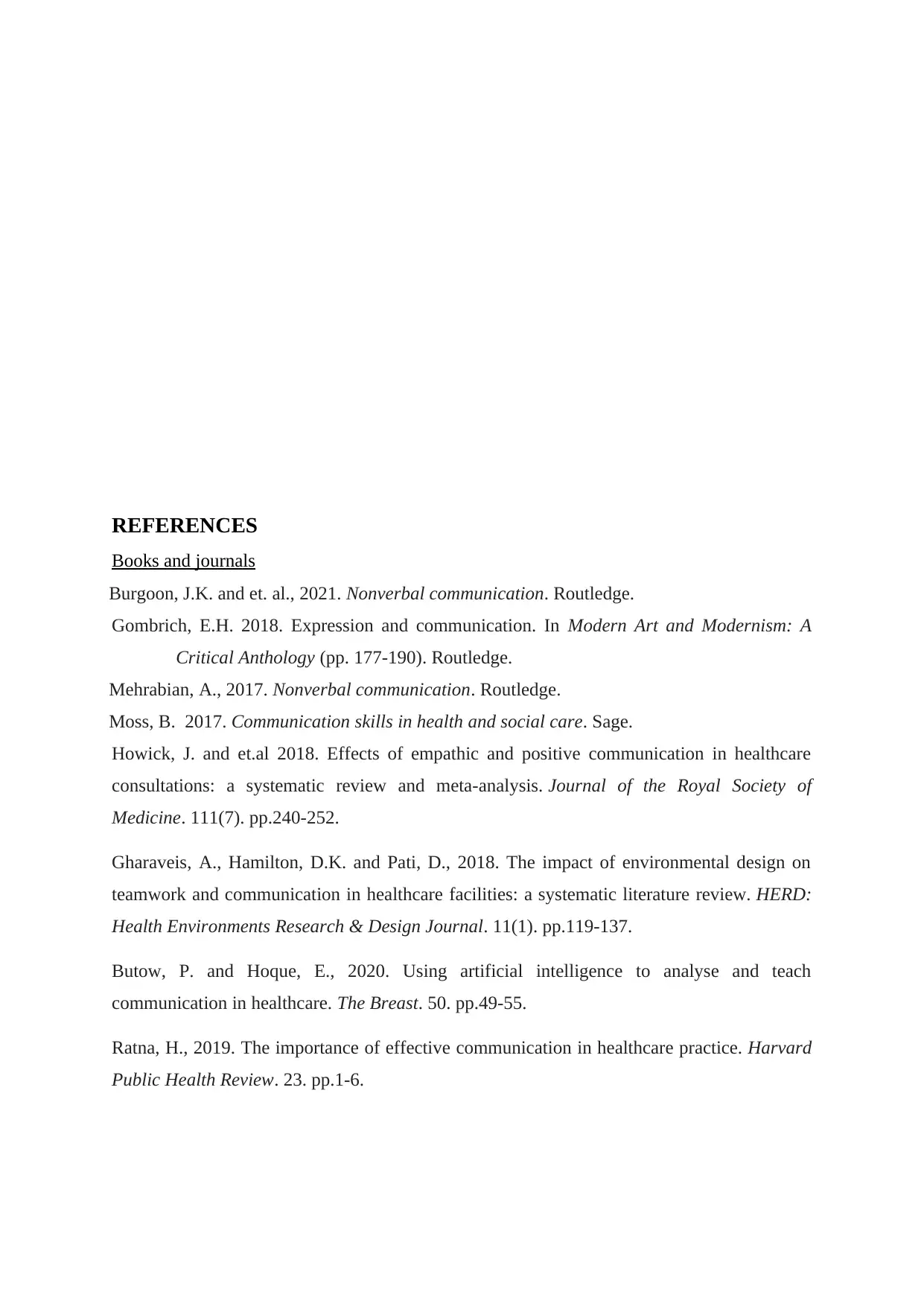
REFERENCES
Books and journals
Burgoon, J.K. and et. al., 2021. Nonverbal communication. Routledge.
Gombrich, E.H. 2018. Expression and communication. In Modern Art and Modernism: A
Critical Anthology (pp. 177-190). Routledge.
Mehrabian, A., 2017. Nonverbal communication. Routledge.
Moss, B. 2017. Communication skills in health and social care. Sage.
Howick, J. and et.al 2018. Effects of empathic and positive communication in healthcare
consultations: a systematic review and meta-analysis. Journal of the Royal Society of
Medicine. 111(7). pp.240-252.
Gharaveis, A., Hamilton, D.K. and Pati, D., 2018. The impact of environmental design on
teamwork and communication in healthcare facilities: a systematic literature review. HERD:
Health Environments Research & Design Journal. 11(1). pp.119-137.
Butow, P. and Hoque, E., 2020. Using artificial intelligence to analyse and teach
communication in healthcare. The Breast. 50. pp.49-55.
Ratna, H., 2019. The importance of effective communication in healthcare practice. Harvard
Public Health Review. 23. pp.1-6.
Books and journals
Burgoon, J.K. and et. al., 2021. Nonverbal communication. Routledge.
Gombrich, E.H. 2018. Expression and communication. In Modern Art and Modernism: A
Critical Anthology (pp. 177-190). Routledge.
Mehrabian, A., 2017. Nonverbal communication. Routledge.
Moss, B. 2017. Communication skills in health and social care. Sage.
Howick, J. and et.al 2018. Effects of empathic and positive communication in healthcare
consultations: a systematic review and meta-analysis. Journal of the Royal Society of
Medicine. 111(7). pp.240-252.
Gharaveis, A., Hamilton, D.K. and Pati, D., 2018. The impact of environmental design on
teamwork and communication in healthcare facilities: a systematic literature review. HERD:
Health Environments Research & Design Journal. 11(1). pp.119-137.
Butow, P. and Hoque, E., 2020. Using artificial intelligence to analyse and teach
communication in healthcare. The Breast. 50. pp.49-55.
Ratna, H., 2019. The importance of effective communication in healthcare practice. Harvard
Public Health Review. 23. pp.1-6.
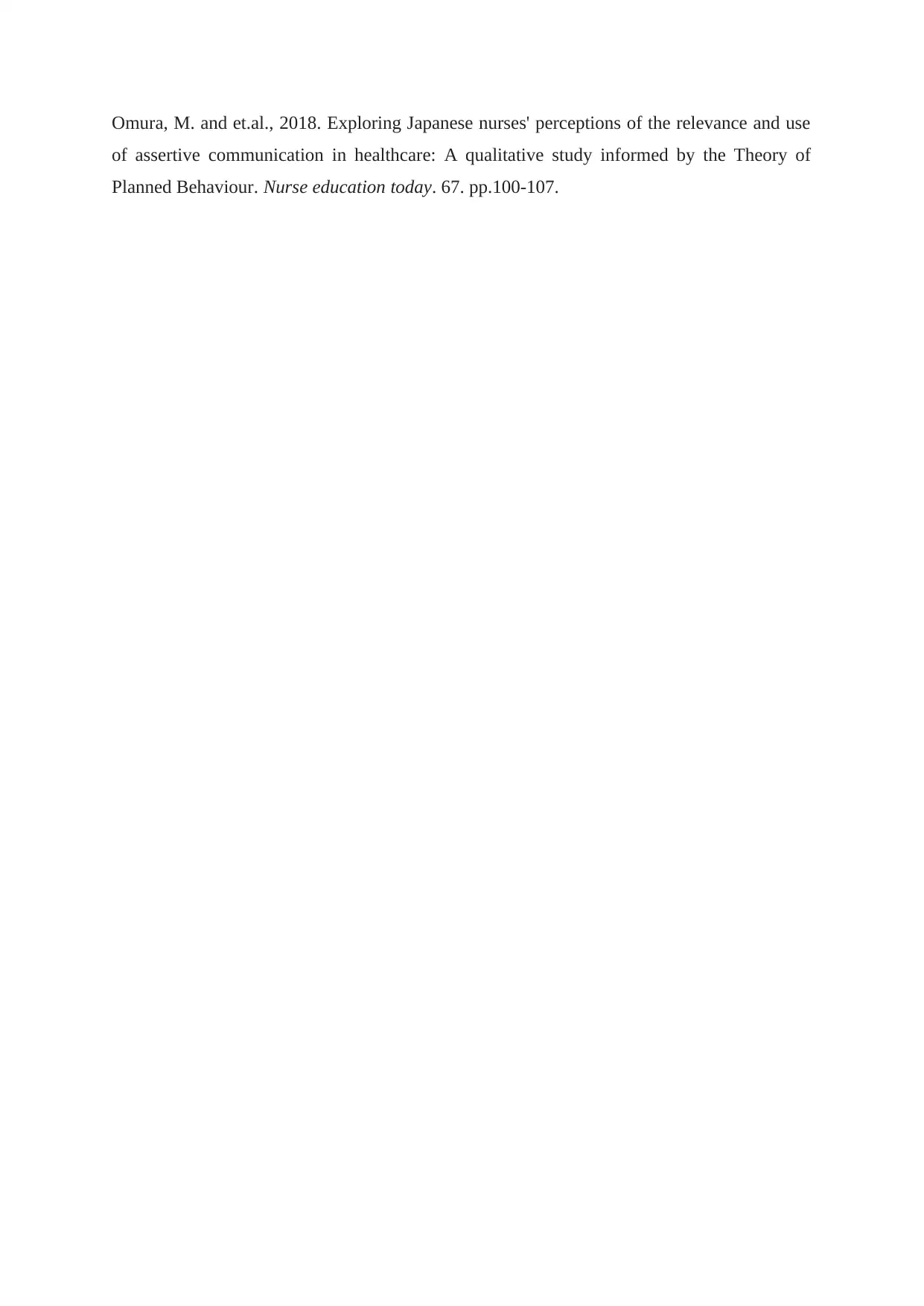
Omura, M. and et.al., 2018. Exploring Japanese nurses' perceptions of the relevance and use
of assertive communication in healthcare: A qualitative study informed by the Theory of
Planned Behaviour. Nurse education today. 67. pp.100-107.
of assertive communication in healthcare: A qualitative study informed by the Theory of
Planned Behaviour. Nurse education today. 67. pp.100-107.
⊘ This is a preview!⊘
Do you want full access?
Subscribe today to unlock all pages.

Trusted by 1+ million students worldwide
1 out of 9
Related Documents
Your All-in-One AI-Powered Toolkit for Academic Success.
+13062052269
info@desklib.com
Available 24*7 on WhatsApp / Email
![[object Object]](/_next/static/media/star-bottom.7253800d.svg)
Unlock your academic potential
Copyright © 2020–2025 A2Z Services. All Rights Reserved. Developed and managed by ZUCOL.




